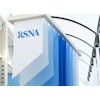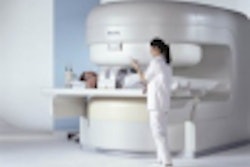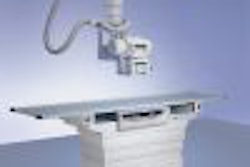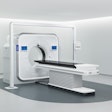
CHICAGO - A new hybrid PET/CT scanner with 16-slice CT capability is a highlight in the RSNA booth of Siemens Medical Solutions. Other new products introduced by the Malvern, PA, company include a 4-D ultrasound scanner and a new line of CT systems.
Biograph Sensation 16 brings premium CT technology to the Biograph product line, which previously employed a dual-slice Emotion scanner. The new system also features the company's ultrafast ceramic (UFC) CT detectors and lutetium oxyorthosilicate (LSO) PET crystals. The new technology pays off with increased throughput: Whole-body oncology scans that once took 30 minutes or more to acquire are now completed in 7-10 minutes, according to Randy Weatherhead, vice president of sales and marketing at the company's Hoffman Estates, IL, nuclear medicine group.
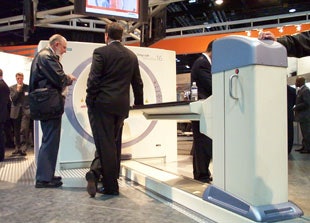 Biograph Sensation 16 is a hybrid PET/CT scanner with 16-slice CT capability. |
Siemens expects oncology to be a major focus of Biograph Sensation 16 users, especially due to the system's 70-cm patient bore. Siemens is displaying the unit with a radiation therapy planning patient table.
The first Biograph Sensation 16 installations will begin in spring 2003, with the product carrying a list price about 20% higher than the next most expensive Biograph system. Siemens will continue to sell Biograph in single- and dual-slice configurations.
Siemens has also redesigned its mid-range Emotion CT product line, developing single-, dual-, and six-slice Emotion systems. The new Emotion units feature gantry rotation times of 600 milliseconds, compared with 800 ms on the older Emotion scanners. Siemens also has introduced new x-ray tubes and generators for the line.
The company's flagship Sensation 16 multislice scanner has been installed at 200 sites since shipments began earlier this year, according to Markus Lusser, segment manager for radiology CT. The company has segmented the Sensation line with the introduction of a 10-slice system, Sensation 10. Another Siemens CT highlight is InSpace, a visualization technique for real-time volume viewing.
Booth visitors interested in browsing Siemens' PACS and IT offerings are able to take in Siemens Workflow Street, which demonstrates how Siemens technology can provide services such as patient registration/order entry, image acquisition and postprocessing, softcopy reading, and image and results distribution.
Included in the display is the firm's Soarian healthcare information system, as well as Integrated Radiology Suite, which combines the vendor's Novius RIS and version 40 of Sienet PACS in a brokerless integration. Version 40 of Sienet includes several enhancements, including wavelet compression and progressive viewing of images over low-bandwidth networks.
In addition, Siemens has been able to improve the speed of the software by cutting out legacy capabilities such as support for old standards like ACR-NEMA 2.0 and DECnet, said Rik Primo, division manager for clinical networking/PACS. Sienet can also now employ centralized or distributed architecture, Primo said.
Support for additional DICOM data formats, such as visible light and endoscopy images, has been included, Primo said. Siemens has also incorporated a more sophisticated global worklist feature, he said.
In ultrasound, the firm's work-in-progress fourSight 4-D imaging technology is taking center stage. Scheduled for release initially on the vendor's Antares scanner, fourSight offers real-time display of 3-D images, said Lars Shaw, director of worldwide marketing for general imaging.
With fourSight, flexible image formats will be accommodated, such as one-to-one, two-to-one, and four-to-one display, Siemens said. Real-time multiplanar reformatting (MPR), volume rendering, volume editing tools, and storage and retrieval capability will also be available, according to the company.
The technology makes use of two newly designed MultiHertz 4-D transducers, which employ a solid-state drive mechanism that confers higher volumes-per-second scan rates and smaller size and weight, Siemens said. Acoustic engineering enhancements allow for wide bandwidth and higher sensitivity, according to the firm.
FourSight has received U.S. Food and Drug Administration 510(k) clearance and is scheduled for release on Antares in the summer of 2003, Shaw said. It will subsequently be migrated to other Siemens scanners, he said.
In other Antares introductions, Siemens is discussing its StellarPlus performance package, which includes workflow enhancements and options such as Tissue Equalization (TEQ), 3-Scape 3-D imaging, Color SieScape panoramic imaging, Cadence contrast agent imaging, and SieClear multiview spatial compounding. StellarPlus will be released in the first quarter of 2003, Shaw said.
Sequoia users may be interested in the company's Signature II option, which includes an imaging package that utilizes CHIRP coded excitation, dynamic transmit focus, coherent phase inversion, real-time spatial compounding, transmit compounding, and background noise suppression. Signature II is available now.
For owners of the firm's legacy 128 and 128XP systems, Siemens is introducing a Gold Standard Bridge program, which provides various financial incentives for the purchase of new Siemens systems.
The vendor's x-ray group is highlighting Axiom Artis TA, a new interventional angiography suite that features rotation speeds as high as 60º per second. The unit also has an in-room 3-D monitor and the option for integrated ultrasound and hemodynamics capabilities. The first Axiom Artis TA system was installed two weeks ago, according to Paul Slater, national sales manager for x-ray and cardiology.
Other x-ray highlights include Axiom Aristos FX, a totally motorized flat-panel radiography system first introduced at the European Congress of Radiology in March. Five of the units have been installed, and at least one site believes that it can replace two x-ray rooms with a single Axion Aristos FX system due to its highly automated operation, Slater said.
Siemens' Maestro software is being featured in the company's MRI section. The software includes Phoenix, a feature that enables users to transfer scanning protocols from a CD, initiating a scan directly from an image. Other features include iPAT, the company's parallel acquisition technology, and PACE, for motion control.
Siemens is also displaying HyperEchoes, an enhancement for the Magnetom Trio 3-tesla scanner that compensates for the influence of the specific absorption rate (SAR) deposition, a common phenomenon when scanning at 3-tesla field strengths, according to John Khoury, national sales manager for MR. Finally, Siemens highlighted the first installation of its Magnetom Rhapsody open 1-tesla scanner, at a Florida site two months ago.
In the women's health segment, Siemens is emphasizing workflow and outcomes. The company continues to pursue its dual path toward full-field digital mammography (FFDM) with both CR and DR systems. Products based on both approaches should begin reaching the market in the second half of 2003, according to Joanne Scott Santos, women's health product manager.
Siemens is also taking advantage of the RSNA to highlight Coherence Dosimetrist, a new workstation for oncology professionals. The product received FDA clearance last month.
By Erik L. Ridley and Brian Casey
AuntMinnie.com staff writers
December 2, 2002
Copyright © 2002 AuntMinnie.com

